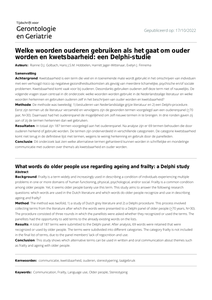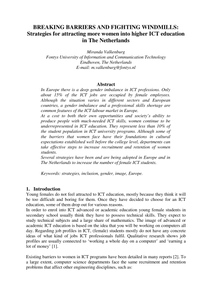Within a short period of time, the Netherlands transformed itself from a relatively tolerant country to a nation that called for cultural assimilation, tough measures and neo-patriotism. The discursive genre of 'new realism' played a crucial role in this retreat from multiculturalism, and that had a dual effect for immigrant women. Whereas formerly they were virtually ignored by both the integration and the emancipation policy, since the triumph of new realism they are in the centre of both policy lines and there is now more policy attention for their needs and interests. Yet in the public debate the culture card is drawn frequently and immigrant women are portrayed as either victims or accomplices of their oppressive cultures. Policy makers and practitioners in the field, however, succeeded in avoiding cultural stereotyping by developing cultural-sensitive measures, while naming them in culture-blind terms.
DOCUMENT

Achtergrond: Kwetsbaarheid is een term die veel en in toenemende mate wordt gebruikt in het omschrijven van individuen met een verhoogd risico op negatieve gezondheidsuitkomsten als gevolg van meerdere lichamelijke, psychische en/of sociale problemen. Kwetsbaarheid komt vaak voor bij ouderen. Desondanks gebruiken ouderen zelf deze term niet of nauwelijks. De volgende vragen staan centraal in dit onderzoek: welke woorden worden gebruikt in de Nederlandstalige literatuur en welke woorden herkennen en gebruiken ouderen zelf in het beschrijven van ouder worden en kwetsbaarheid?Methode: De methode was tweeledig: 1) bestuderen van Nederlandstalige grijze literatuur en 2) een Delphi-procedure. Eerst zijn termen uit de literatuur verzameld en vervolgens zijn de gevonden termen voorgelegd aan een ouderenpanel (>70 jaar, N=30). Daarnaast had het ouderenpanel de mogelijkheid om zelf nieuwe termen in te brengen. In drie ronden gaven zij aan of zij de termen herkennen dan wel gebruiken.Resultaten: In totaal zijn 187 termen voorgelegd aan het ouderenpanel. Na analyse zijn er 69 termen behouden die door ouderen herkend of gebruikt worden. De termen zijn onderverdeeld in verschillende categorieën. De categorie kwetsbaarheid komt niet terug in de definitieve lijst met termen, wegens te weinig herkenning en gebruik door de panelleden.Conclusie: Dit onderzoek laat zien welke alternatieve termen gehanteerd kunnen worden in schriftelijke en mondelinge communicatie met ouderen over thema’s als kwetsbaarheid en ouder worden.
DOCUMENT

The number of employees above 50 is increasing in organizations because of demographic changes. People above 50 feel less involved in work and societal activities as they should be and as they are expected to be. Older workers‟ employment is accompanied by stereotyping that workers are less productive and less capable than younger workers. The current research is about older workers‟ wishes, desires and wants to further develop gradual retirement schemes as scenarios for both employers' and employees' mutual benefit. Furthermore, the perception of ICT tools supportiveness is researched for older workers‟ sustainable employability. The study is conducted in the northern part of the Netherlands and data were collected by questionnaires and interviews. Data were analysed with the statistical tool SPSS and with Excel for the search of patterns. Results suggest that workers between 50 and 65 like to retire gradually by applied flexible working schemes, reducing the workload and reducing the weekly hours. ICT tools are considered as helpful tools as long as they do not affect workers‟ health. Training is required as well as constantly being updated in the ICT arena. Respondents also indicated that they want to work after retirement either voluntarily or on a small-scale salary to cover their basic costs.
DOCUMENT
The relationship between race and biology is complex. In contemporary medical science, race is a social construct that is measured via self-identification of study participants. But even though race has no biological essence, it is often used as variable in medical guidelines (e.g., treatment recommendations specific for Black people with hypertension). Such recommendations are based on clinical trials in which there was a significant correlation between self-identified race and actual, but often unmeasured, health-related factors such as (pharmaco) genetics, diet, sun exposure, etc. Many teachers are insufficiently aware of this complexity. In their classes, they (unintentionally) portray self-reported race as having a biological essence. This may cause students to see people of shared race as biologically or genetically homogeneous, and believe that race-based recommendations are true for all individuals (rather than reflecting the average of a heterogeneous group). This medicalizes race and reinforces already existing healthcare disparities. Moreover, students may fail to learn that the relation between race and health is easily biased by factors such as socioeconomic status, racism, ancestry, and environment and that this limits the generalizability of race-based recommendations. We observed that the clinical case vignettes that we use in our teaching contain many stereotypes and biases, and do not generally reflect the diversity of actual patients. This guide, written by clinical pharmacology and therapeutics teachers, aims to help our colleagues and teachers in other health professions to reflect on and improve our teaching on race-based medical guidelines and to make our clinical case vignettes more inclusive and diverse.
MULTIFILE

In the social sciences, especially in social psychology and sociology, fear of the unknown and the tendency to favour the group one belongs to are recognised phenomena. This chapter will look at elements of these scientific theories and establish a link between these elements and the initial findings of a study of Syrian refugees on the Dutch labour market. First, this study is described, after which a glimpse into the world of social psychology is provided. This chapter concludes by taking a wide perspective on Dutch society and by discussing some lessons that can be learned for a diverse future. Research and education can support society in highlighting the importance of diversity and in training people to recognise the added value of diversity. Everyone will need to put considerable effort into ensuring people are judged for their personal qualities. Lecturers and professionals will need to examine their own judgements and biases first, before they can help to shape the perceptions of students. Together with students, lecturers can promote the benefits of the contact hypothesis and the concept of interactional diversity.
DOCUMENT

The current transnational climate (British Council, 2014) in Europe is likely to continue to generate institutional and classroom situations which dictate that difference and otherness be the norm rather than the exception. Unfortunately, in the 1960's, Black and minority ethnic (BME) migrants from the former British colonies had less-than-favorable educational experiences in Britain due to prejudice and stereotyping mainly arising from cultural differences. Since then there have been a plethora of studies, policies, and reports regarding the perpetuation of discrimination in educational institutions. Today, British higher educational institutions have finally begun to recognize the need to reduce progression and attainment gaps. However, their focus tends to only consider the student “Black and Minority Ethnic attainment gap” with almost no attention being given to educators', or more specifically there is a distinctive lack of thought given to the female BME educators' progression and attainment in British HEIs. As such, this paper draws theoretically and conceptually on critical cultural autoethnography, to illustrate the value of conducting research into a female's BME educators' personal and professional experiences, and “gives voice to previously silenced and marginalized experiences” (Boylorn and Orbe, 2014, p. 15). In doing so, I highlight how higher educational institutions underutilisation of such competencies and contributions have and continue to perpetuate BME underachievement. I conclude the paper by questioning the accountability of providing support for BME educators progression and attainment, challenge educational leaders to consider the value and utilization of cultural knowledge, and implore all educators to reflect on how their personal experiences influence their professional identity.
MULTIFILE
Background and ObjectivesThis qualitative study applied a resilience perspective to socioeconomic inequalities in the functioning of older adults. We aimed to gain insight into how some older adults managed to age successfully despite having a low socioeconomic position (SEP) throughout their lives.Research Design and MethodsSemistructured interviews were conducted with 11 resilient adults over the age of 79 years participating in the Longitudinal Aging Study Amsterdam, the Netherlands. Participants were defined as resilient on the basis of having a low lifetime SEP and favorable trajectories of physical, mental, and social functioning. Grounded Theory coding techniques were applied to identify themes reflecting distinct ways in which participants dealt with what they indicated were the most significant adversities in their lives. The analysis focused on experiences linked to socioeconomic conditions.ResultsSix themes reflecting psychological, behavioral, and social factors were derived from the data: drawing support from social contacts; investing in younger generations; taking actions to manage or improve socioeconomic conditions; putting the impact of a low SEP into perspective; persevering; and resigning oneself to adversity.Discussion and ImplicationsFindings suggest that successful aging despite a low SEP throughout one’s lifetime requires considerable psychological and social resources. In addition, resignation and specific manifestations of generativity are identified as new elements of resilience. These findings may help to reduce the stereotyping of older adults with a low SEP, and nuance the heroic image of resilience as something that is primarily attributable to extraordinary individual abilities or efforts.
DOCUMENT
In Europe there is a deep gender imbalance in ICT professions. Only about 15% of the ICT jobs are occupied by female employees. Although the situation varies in different sectors and European countries, a gender imbalance and a professional skills shortage are common features of the ICT labour market in Europe. At a cost to both their own opportunities and society's ability to produce people with much-needed ICT skills, women continue to be underrepresented in ICT education. They represent less than 10% of the student population in ICT university programs. Although some of the barriers that women face have their foundations in cultural expectations established well before the college level, departments can take effective steps to increase recruitment and retention of women students. Several strategies have been and are being adopted in Europe and in The Netherlands to increase the number of female ICT students.
DOCUMENT

Huiselijk geweld lijkt sterk toe te nemen tijdens de Covid-19 pandemie. Wat opvalt in de berichtgeving, is dat er stelselmatig wordt uitgegaan van mannelijke daders en vrouwelijke slachtoffers. Is dit wel terecht? In dit artikel beschrijven Vivienne de Vogel en Kasia Uzieblo dat ook vrouwen huiselijk geweld plegen en gaan ze in op de weerstand in de maatschappij om vrouwen als pleger én om mannen als slachtoffer te zien van huiselijk geweld. The prevalence of domestic violence seems to be increasing during the COVID-19 pandemic. In most media coverage and calls for preventive initiatives from professionals and policy, males are consistently portrayed as perpetrators of domestic violence and females and children as victims, also by leading organizations like the WHO. However, research has clearly shown that there are more types of domestic violence, like sibling and elder abuse and that women are also capable of serious violence towards their family. The current article aims to summarize the literature on gender and domestic violence, and to discuss the societal reluctance to acknowledge females as potential perpetrators, and males as potential victims.
DOCUMENT

A Europe-wide revival of the idea of bildung as a goal for education has been gaining momentum for a couple of decades. The main idea is that bildung enables teachers, researchers and policy makers “… to explore the ways in which education might be about something more than simply the transmission of our facts and values to the next generation,” to use a quote by Gert Biesta, the Dutch professor of educational theory and pedagogy at the University of Edinburgh. Others often narrow bildung down to a process of becoming a whole person or cultivating one’s self towards civic excellence. Those ideas come from an older tradition with bildung thinkers such as the 19th century Prussian minister of education, Wilhelm von Humboldt, who promoted bildung as a key objective of public education.
DOCUMENT
